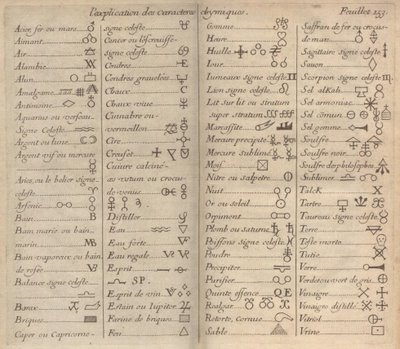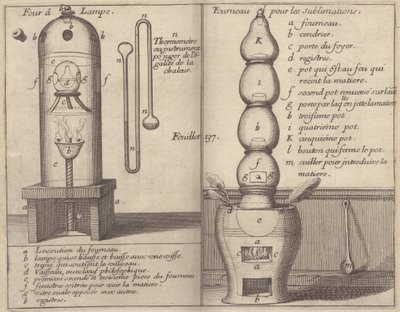
"Armes d'Antoine Vallot de Magnant Dandeuille"

Frontpiece - 'Traicté de la Chymie'

"Tour d'Athanor, Bain de sable, Bain marie, Vaisseau
pour séparer les huiles distillées, Fourneau et vaisseaux
pour la distillation des eaux, des esprits, et des huiles"
pour séparer les huiles distillées, Fourneau et vaisseaux
pour la distillation des eaux, des esprits, et des huiles"
![Vaisseau pour alkoholiser [alcooliser] l'esprit de vin dès la première distillation, Fourneau commun.](http://photos1.blogger.com/x/blogger/1717/1584/400/320624/Vaisseau%20pour%20alkoholiser%20%5Balcooliser%5D%20l%27esprit%20de%20vin%20d%3F%3Fs%20la%20premi%3F%3Fre%20distillation%20%3B%20Fourneau%20commun.%20%2C%20planche%20h.-t.%20contenant%20du%20texte%20gr.s.c..jpg)
"Vaisseau pour alkoholiser [alcooliser] l'esprit de vin
dès la première distillation, Fourneau commun."
dès la première distillation, Fourneau commun."

"Fourneau et vaisseaux pour distiller les végétaux."

"Explication des caractères chimiques."

"Fourneau et vaisseaux pour faire l'huile de soufre,
Cloche pour faire l'aigre ou l'esprit de soufre."
Cloche pour faire l'aigre ou l'esprit de soufre."

"Calcination solaire de l'antimoine."

"Four à lampe, Thermométre, Fourneau pour les sublimations."

"Four à vent ou le fourneau de fonte, Réfrigéré complet, Aeolipile"
Nicaise Le Févre (1610-1669) didn't have formal tertiary education. Instead, he apprenticed under his apothecary father until his father died, and subsquently he was taught by a medical Professor from L'Académie de Sedan.
Le Févre worked as a Master Apothecary at his father's business when his training was completed and later moved to Paris where he gave private lessons in pharmaceutical chemistry and became well known as an educator among the Parisian aristocracy. His elite connections resulted in Le Févre being appointed "demonstrator in chemistry at the Jardin du Roi and in 1654 he obtained the privilege of a royal apothecary and distiller."
One of his students was King Charles II who set up Le Févre with a laboratory in St James Palace in London as part of his appointment as Royal Professor of Chemistry and Apothecary to the Royal household. He was also elected a Fellow of the Royal Society.
Le Févre is best remembered for his 1660 publication in 2 volumes, 'Traicté de la Chymie', one of the foremost chemistry texts of the 17th century. It was translated into english, latin and german and a number of editions were released in the following 80 years. The extended title of the work translates (by me, in updated language) as:
***'Compendium of Chemistry' - The first volume will be used as an introduction and for instruction both in relation to the theory of this science in general, and as a means to outline the experimental methods of the art which can be applied to animals, plants and minerals without loss of their essential virtues. The second volume continues to outline the process of making extractions ('juices') from plants and minerals.***
'Traicté de la Chymie' is perhaps a good example of a work that manages to straddle both the middle ages and the modern scientific world. It belongs at once to the fields of alchemy and chemistry and was written by an apothecary and a pharmacist. His 'Traicté' is said to be modelled after the 1636 'Abrégé des secrets Chymiques' by famous alchemist, Pierre Jean Fabre and I noted a passing reference to another famous alchemist, Raymond Llull, in the preface.
"Le Févre's eclectic chemical theory combined Paracelsian, Helmontian and Aristotelian ideas. He believed in five elements, adding phlegm and earth to Paracelsus' tria prima of salt, sulphur and mercury."
Le Févre: "Chymistry is the art and knowledge of nature itself; it is by her means that we examine the Principles, out of which natural bodies do consist and are compounded; and by her are discovered unto us the causes and sources of their generations and corruptions; and of all the changes and alterations to which they are liable."This notion of an emerging scientific logic from a philosophical or (some might say) superstitious belief system is one that has greatly interested me during the life of this site. It's fascinating observing with hindsight the development of rational thinking from a quagmire of folklore and spurious ideas. The laboratory equipment in the engravings above convey that alchemy/chemistry duality well. Click the images for full size versions - there are no further illustrations in the 2 volumes which are online in full at Pôle Universitaire Européen Lille-Nord.
- Nicaise Le Févre at The Galileo Project.
- Abstract: 'Chemical Textbooks in the Seventeenth Century' by Antonio Clericuzio.
- 'Foreign bodies: Travel, empire and the early royal society of London' by Robert Illiffe (p.21).
- €2415 for a 1669 edition (with notes) {halfway down page}
- The title page from an english edition.
For a happy 2007 full of visual feasts ; I've really enjoyed your blog in 2006 and will keep on lurking!)
ReplyDeleteBonne année PK ! a happy new year 2007 for you and "BibliOdyssey" !
ReplyDeleteThank you. Happy New Year everybody!!
ReplyDelete